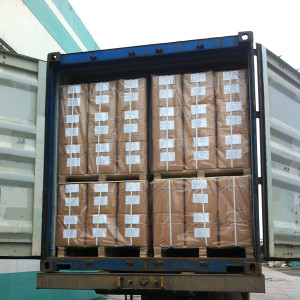JP = Japanese Pharmacopeia
FCC = Food Chemical Codex
Aspartame High density powder (HDP) is an artificial, low calorie sweetener used as a sugar substitute in some foods and beverages more than 150 countries. In the European Union, it is codified as E951. It was first sold under the brand name NutraSweet.The safety of aspartame has been the subject of aspartame controversies, aspartame side effects has arisen since its initial approval by FDA.The EFSA concluded in its 2013 re-evaluation that aspartame and its breakdown products are safe for human consumption.However, because its breakdown products include phenylalanine, aspartame must be avoided by people with the genetic condition phenylketonuria (PKU).
Aspartame High density powder(HDP) with its good solubility and fluibility, some food products specially need it, especially in drink industry.
Aspartame, an artificial sweetener, is approximately 200 times sweeter than sucrose.Due to this property, even though aspartame produces four kilocalories of energy per gram when metabolized, the quantity of aspartame needed to produce a sweet taste is so small that its caloric contribution is negligible. The taste of aspartame and other artificial sweeteners differs from that of table sugar in the times of onset and how long the sweetness lasts, though aspartame comes closest to sugar’s taste profile among approved artificial sweeteners. The sweetness of aspartame lasts longer than sucrose, so it is often blended with other artificial sweeteners such as acesulfame potassium to produce an overall taste more like sugar. Aspartame can be synthesized from its constituent amino acids, L-phenylalanine and L-aspartate.
Aspartame High density powder (HDP) is mainly used in Beverage (need fast solubility), Dry Powder Mixes, Tabletops, Chewable Vitamins, Pharmaceuticals.
Aspartame High density powder (HDP) Specification
|
Test Item |
Specification |
Test Method / Reference |
|
Appearance |
White Powder |
Visual |
|
Odor/Taste |
Conforms to Quality Standards |
Internal Method |
|
Identification |
Meets Requirements |
Current FCC / USP/NF / JECFA / EP |
|
Assay (on dry basis) |
98.0% to 102% |
Current FCC / USP/NF / JECFA / EP |
|
Loss on Drying |
≤ 4.5% |
Current FCC / USP/NF / JECFA / EP |
|
Residue on Ignition / Sulphated Ash |
< 0.2% |
Current FCC / USP/NF / JECFA / EP |
|
Optical (Specific) Rotation |
+14.5° and +16.5° |
Current FCC / USP/NF / JECFA / EP |
|
*Conductivity |
≤ 30 μScm-1 |
EP |
|
Transmittance |
≥ 95% |
Current USP/NF /JECFA |
|
Extraneous Matter |
Free From Material Foreign to Product |
Free From Visual Evidence |
|
pH (0.8% Solution) |
4.5 ~6.0 |
Current FCC/JECFA |
|
Heavy Metal (as Pb) |
≤ 10 ppm |
Current USP/NF / JP / EP |
|
Lead |
< 1 ppm |
Current FCC / JECFA |
|
Arsenic |
< 3 ppm |
Current FCC |
|
Residual Solvents |
Meets Requirements |
Current USP/NF |
|
5-benzyl-3,6-dioxo-2-Piperazineacetic Acid (DKP) Other Related Substances |
≤ 1.5% ≤ 2.0% USP/NF; ≤ 1.5% EP |
Current USP / NF / FCC / JECFA Current USP/NF |
|
L-phenylalanine |
≤ 0.5% |
Current EP |
|
Solubility |
Completely Dissolves |
Internal Method |
|
Bulk Density |
0.5 +/- 0.1 g/mL |
Internal Method |
|
Total Aerobic Plate Count |
≤ 250 CFU/g |
GB |
|
Yeast and Mold Count |
≤ 100 CFU/g |
GB |
|
Coliforms |
≤ 3.0 MPN/g |
GB |
|
Escherichia Coli |
Negative/g |
GB |
|
Salmonella |
Negative/25g |
GB |
CFU = Colony Forming Units
EP = European Pharmacopeia
USP/NF – United States Pharmacopeia-National Formulary
GB= China National Standard Method
JECFA = Joint FAO/WHO Expert Committee on Food Additives
